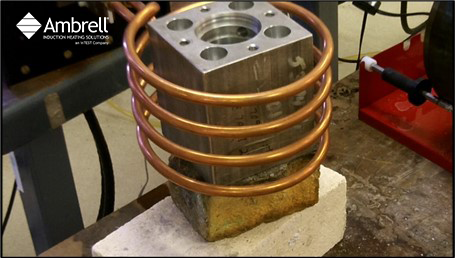Induction Brazing an Aluminum Assembly
Objective A company wanted to assess using induction heating for their aluminum assembly brazing process, and contacted THE LAB at Ambrell to utilize...
Applications
Applications: More
Applications: More

Industries:
Industries: More
Industries: More
Industries: More

Products:
Products: More
Services:
Services: More

Learn:
Learn: More
About:

1 min read
Brett Daly
3/19/21 3:03 PM

A client contacted THE LAB at Ambrell because they needed to heat a steel tube and an aluminum block for a cylinder liner coating curing application in the automotive industry. THE LAB did testing and determined that an EKOHEAT® 30 kW, 50-150 kHz induction heating system equipped with a remote workhead would be optimal for this application. The target temperature for the application was 400 °F (204 °C). Two coils were used for this application: a single position two-turn channel coil and a single position four-turn helical coil.
The steel tube used the channel coil and it was placed in the rotating system and then put inside the coil. Temperature indicating paint was applied. The rotating device was turned on and then the induction power was turned on. After 90 seconds the temperature indicating paint had melted and the coating began to melt.
The aluminum part used the helical coil and it was placed inside that coil with temperature indicating paint applied to both the inside and outside of the block. The power was turned on and the part began to heat. After 90 seconds the temperature indicating paint began to melt. Given that there were magnetic steel and aluminum parts with different coupling efficiencies, auto tap was utilized so the EKOHEAT could automatically select the correct tap.
The client had been using an oven, and induction heating offered them several benefits:
Speed: The client's oven had a heating time of ten minutes for this curing application, so the time savings were considerable with induction. This increase in speed led to a faster production rate.
Precise, repeatable heating: Induction is highly repeatable and it heats only the portion of the part that requires it. With an oven you're typically forced to heat the entire part.
Floor space: An oven takes up considerable floor space, so they saved significant floor space with induction. Given that the workhead can be placed away from the power supply, the space savings can be even more considerable.
Visit our website to see even more induction curing applications and automotive applications. If you have a heating application that might benefit from induction heating, contact our experts in THE LAB and take advantage of free applications testing. Send in your parts, they'll record the process, send you a report, ensure it's feasible, and make a system recommendation based on your requirements.

Objective A company wanted to assess using induction heating for their aluminum assembly brazing process, and contacted THE LAB at Ambrell to utilize...

Induction heating is a process that uses electromagnetic fields to heat electrically conductive materials. It has been used in numerous industries...

Induction heating, a process that uses electromagnetic induction to heat electrically conductive materials, is often thought of for large industrial...